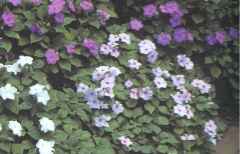Vol.
2 #128
July 7, 2001
Just Your Garden Variety Impatiens
 One
of my favorite sights in July is a bed of common impatiens (Impatiens
wallerana) unleashing their spectacular display of color. Deep
in the cavernous shade of my woodland yard where tree roots rule, these
colorful and robust annuals dominate the landscape... The profusion
of bloom is more stunning than the burst of mint from a York Peppermint
Patty... Their color deeper than the oceans... Okay, impatiens
are pretty fine plants. Enough already.
One
of my favorite sights in July is a bed of common impatiens (Impatiens
wallerana) unleashing their spectacular display of color. Deep
in the cavernous shade of my woodland yard where tree roots rule, these
colorful and robust annuals dominate the landscape... The profusion
of bloom is more stunning than the burst of mint from a York Peppermint
Patty... Their color deeper than the oceans... Okay, impatiens
are pretty fine plants. Enough already.
Landscape design is as much art as science. Occasionally, I have
the pleasure of attending seminars in which designers will toss out fresh
ideas, often thinking "outside of the box". I have never left a presentation
where I did not pick up new and exciting information. The problem
is that invariably a designer will "slam" a common plant, simply because
it is overdone. These days, impatiens can rank high on the "slam
list". A lack of originality, "been there, done that", and so forth.
The reason a plant such as the impatiens is used so widely it because it
is easy to grow and it is so beautiful. If a plant gives you personal
pleasure, then why not use it in the landscape? Some 30 years ago
the tomato was the number one selling bedding plant. Ten years ago,
the tomato accounted for 1% of the bedding plant market, yielding the number
one ranking in the marketplace to the impatiens with 35% of the bedding
plant market. I really don't know any current bedding plant statistics,
but I know our tastes and choices have much greater variety than in the
past. There is still always a little space for impatiens.
The culture of this plant is simple. The more shade, the happier
the impatiens. It is truly sad to watch someone try to grow impatiens
in full sun. I work up a bed in mid to late April, when I'm comfortable
no frost will come again. I then incorporate some compost and a little
slow release fertilizer, plant my impatiens seedlings a foot apart, and
gently mulch them in with some fine pine bark. Beyond this, I only
add generous amounts of water as needed. No "dead heading" (removal
of spent blooms) is needed. Last year, excessive rains made my impatiens
a little less spectacular than usual, but they coped and bloomed.
A dry, wilting impatiens will rise and salute you in about an hour when
re-hydrated.
Three years ago, I tried one of those products where the impatiens seed
is mixed in with dyed paper mulch. Simply spread and water.
I worked up my bed, spread, and watered. In order to keep the mulch
moist for germination I had to water faithfully twice a day. The
area where the sun hit the bed in the middle of the day failed to yield
anything. As for the rest of the mulch blend, I got my first flowers
in late July. Had I planted a sunny wildflower mulch mix, I would
have had to quit my job to stay home and water.
Two years ago, I was watching the weather station for frost. I would
also look out my window to see if I needed to scrape the frost from my
windshield. By the end of the first week in April, I realized that
the neighbors' windshields had frost, but mine did not because of the heavy
tree canopy. I planted on April 11th and made up for lost time from
the previous "mulch" year. I wouldn't always recommend April 11th,
but my experience shows that you can push your limits in the shade.
By the end of the growing season, you should notice little curled springs
forming on your plants. Years ago, knowing the frost was coming,
I dug up some impatiens and put them in pots on my sideboard in the living
room. One evening, while reading, I kept hearing a clicking noise.
Turns out these little curled springs were shooting seeds around the living
room, though they were not big enough to see. Drove me crazy for
a couple of hours. This is why you sometimes see large volunteer
beds of impatiens the year after you have planted them.
This was going to be a short column. I guess I just get excited about
impatiens. See you next week.
Andy Lynn
 One
of my favorite sights in July is a bed of common impatiens (Impatiens
wallerana) unleashing their spectacular display of color. Deep
in the cavernous shade of my woodland yard where tree roots rule, these
colorful and robust annuals dominate the landscape... The profusion
of bloom is more stunning than the burst of mint from a York Peppermint
Patty... Their color deeper than the oceans... Okay, impatiens
are pretty fine plants. Enough already.
One
of my favorite sights in July is a bed of common impatiens (Impatiens
wallerana) unleashing their spectacular display of color. Deep
in the cavernous shade of my woodland yard where tree roots rule, these
colorful and robust annuals dominate the landscape... The profusion
of bloom is more stunning than the burst of mint from a York Peppermint
Patty... Their color deeper than the oceans... Okay, impatiens
are pretty fine plants. Enough already.